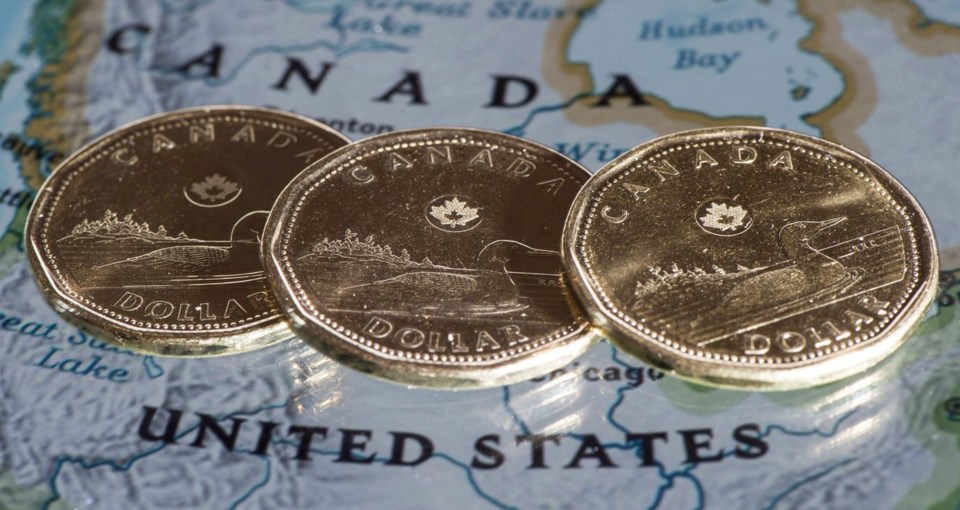TORONTO — The Canadian dollar is trading against the U.S. dollar at levels not seen since 2020 as the combined pressures of economic outlooks, elections, and energy prices weigh. Here's what you need to know.
What's happening with the Canadian dollar?
Canada's currency sunk just below 72 cents US on Monday for the first time in more than four years, breaking through the 72 to 76 cent band it has been trading within in recent months.
The loonie fell further on Tuesday, and continued to inch down on Wednesday, closing at 71.86 cents US.
The lower loonie should help industries like tourism because it can encourage more Americans to travel north to get more bang for their buck, but for anyone travelling to the U.S., or buying things in U.S. dollars, it means paying more.
What's driving down the currency?
The biggest driver of the split between the Canadian and U.S. dollar is the diverging economic outlooks, and the interest rate decisions linked to those. That's because the higher the central bank interest rate, the more worthwhile it is to hold that country's currency.
Canadian economic growth is looking weaker than the U.S., leading the Bank of Canada to cut its key interest rate by an unusually high half a percentage point to 3.75 per cent last week. It was the fourth consecutive cut by the central bank and economists expect continued cuts ahead. With the U.S. economy seeing stronger growth, there's less pressure and expectations of the path to lower rates from the U.S. Federal Reserve.
"The U.S. economy feels a lot more resilient. So the assumption is that they're not pressured, the Fed isn't pressured to reduce rates as much as it is in Canada," said Rahim Madhavji, president at Knightsbridge Foreign Exchange Inc.
Crude prices have fallen recently, down below US$70 a barrel, to also weigh on the loonie.
There's also an increasing election trade betting on a Trump win that's also putting pressure on the Canadian dollar, he said. The potential for trade wars and downward oil price pressure if he does win is also helping boost the U.S. dollar.
"The outlook in the near term is definitely grim for the Canadian dollar," said Madhavji.
What's the outlook?
Scotiabank strategist Hugo Ste-Marie said in a recent note that he's been bearish for some time on the loonie. The director of portfolio and quantitative strategy says the Canadian dollar could re-test the lows of the past two decades, such as 2020 and 2016 when the loonie neared 68 cents US, if it pushes below the 72 cent threshold, which it now has. Ste-Marie said the expectation is the Canadian dollar will bounce back next year, but that the level that it's expected to recover to keeps inching down as well.
"We continue to see more downside risk than upside risk going forward," he said.
Much of the pressure from the diverging rate path with the U.S. has already been baked into the price, but there's still a question of just how much the economies split, said Madhavji.
"The question is, how poorly does the Canadian economy do with immigration levels basically being lowered, and what is the ripple effect of that?" he said.
"That potentially forces the Bank of Canada to lower rates to boost the economy even further, just because there's less people coming in."
The question, he said, is just how much of those shifting fortunes have been accounted for.
Who benefits from a lower loonie?
A lower Canadian dollar can boost industries like tourism, where the weaker dollar increases visitors from abroad, especially from the U.S., as their money goes further here.
It can also mean bigger profits for Canadian businesses that export, like the oil and gas industry, forestry and manufacturing.
The lower loonie can also boost TSX company earnings. Ste-Marie said that, all else equal, a five per cent decline in the annual average of the Canadian dollar would push earnings up by about two per cent.
Where does it hurt?
A lower loonie means travelling abroad can be more expensive for Canadians, including those planning to travel south for the winter.
A lower loonie also means imports are more expensive, including in key investments for companies, noted Ste-Marie.
"An even weaker currency would not help Canadian businesses to invest more in machinery/equipment/IT, which are all imported and badly needed to solve weak Canadian productivity issues."
This report by The Canadian Press was first published Oct. 30, 2024.
The Canadian Press




